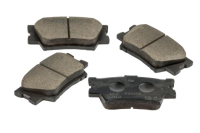The Toyota Camry, a practical and reliable sedan, inexpensive to maintain with excellent performance and superb styling, is an iconic car whose first generation was introduced back in 1982. Now cars of this brand have changed beyond recognition and with each new model look even more prestigious and distinctive. Kamri exterior visually captures the eye of others, all the body parts harmoniously combined with each other, the grille made of chrome, complex shape optics, a powerful bumper. Interior is comfortable and ergonomic, trimmed with high-quality leather with inserts resembling wood, basic configuration includes multirule, two-zoned climate control, 16-inch alloy wheels, in more expensive configurations such options are included as: Toyota Touch 2 multimedia system, rear view camera, Bluetooth, leather steering wheel, electrically adjustable driver and passenger seats with multiple directions, engine start from button, air ioniser, keyless entry system and many other features, the main feature of the Exclusive version, is the presence of a modern multimedia system on the Android platform. In order to make the journey as comfortable as possible, the car is equipped with a number of electronic aids, as well as safety systems, such as: ESP, BAS, VSC, EBD, ASR, ABS and belt pretensioners, front and side airbags, Isofix, front and rear parking sensors, blind spot monitoring system and automatic switching of high beam to low beam. It is worth noting that the Toyota Camry produced for the American market, in some of the restyling versions differ not only visually optics and body parts, but also have differences in some parts of the braking system, namely the brake pads, details can be found here.
Rules for choosing brake pads for your Toyota Camry.
Reliable control and effective braking on roads with any road surface provides a brake system and brake pads made from modern materials with high quality, which have a unique friction composition, which includes components such as: mineral fibers, high-temperature resin, Kevlar, copper, graphite, carbon, glass, organic compounds that directly affect the effectiveness of vehicle braking and provide excellent heat dissipation. There are four types of pads, depending on the type of friction material: low-metal, organic, semi-metal and ceramic. It is important to know that the brake pads for the European market and Europe have different configurations, and pick up the correct and high quality pads which are 100% suitable for your car can be on this site. When choosing pads be sure to consider your driving style, operating conditions, operating temperature and the coefficient of friction. For normal city driving, the optimum operating temperature for brake pads is 350ºC. Particular attention should be paid to the external appearance of the product, the packaging must bear a certification mark, the friction layer must be even, with no chips and cracks, do not skimp too much on pads, because their quality affects the safety of the road. As for choice of manufacturer, most car owners consider American, German, Korean, Italian, Spanish brake pads to be the most worthy ones.


-rear-and-front-view-camera-6.png)

